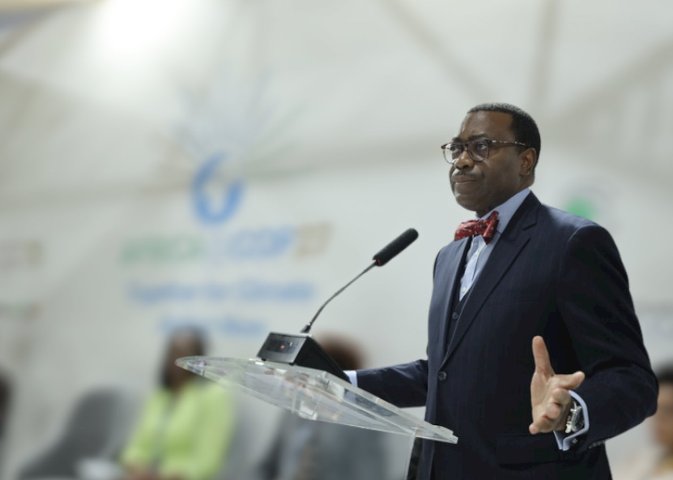Africa Braces for U.S. Tariff Shocks as Adesina Urges Strategic Shift and Self-Reliance
According to Dr. Adesina, 47 out of 54 African countries stand to be directly impacted by the new U.S. trade policies.

- Country:
- Ivory Coast
As the United States intensifies its protectionist trade stance, the global economic repercussions are being felt far beyond its borders—now shaking the foundations of Africa’s already fragile economies. In an exclusive interview with CNN’s Christiane Amanpour, Dr. Akinwumi Adesina, President of the African Development Bank Group (AfDB), sounded a grave warning about the looming consequences of the recently imposed higher tariffs by the U.S. administration, which he describes as a looming economic shockwave across the African continent.
According to Dr. Adesina, 47 out of 54 African countries stand to be directly impacted by the new U.S. trade policies. These tariffs threaten to erode export revenues, weaken foreign exchange reserves, and accelerate inflation across nations heavily reliant on imports. “Most of these countries are import-dependent,” he said. “When their currencies weaken, you get rising inflation and a worsening debt burden, especially for countries with foreign currency debt.”
The Heaviest Hit: African Exporters and Aid Beneficiaries
Among the most adversely affected are Lesotho, Madagascar, Mauritius, Botswana, Angola, Algeria, and South Africa. These countries face tariffs as high as 50 percent on nearly all their export products, effectively pricing them out of the U.S. market. Compounding this setback, substantial cuts to USAID programs are already straining critical healthcare and humanitarian efforts across the region, threatening access to essential medicines and services.
These developments signal a stark re-evaluation of Africa’s economic vulnerability and overreliance on a single trade partner. Dr. Adesina noted that despite the friction, Africa's trade volume with the U.S. remains relatively modest—only 1.2 percent of U.S. global trade, or about $34 billion, with a trade surplus of just $7.2 billion.
A Three-Pronged Response: Africa’s Strategic Repositioning
Rather than confrontational rhetoric, Dr. Adesina proposed a pragmatic and forward-looking response. His three-point strategy for the continent includes:
-
Constructive Trade Diplomacy: Proactively engage with the United States in flexible and inclusive trade negotiations.
-
Diversified Export Partnerships: Seek new markets in Asia, Europe, Latin America, and intra-Africa trade to reduce dependency on any one partner.
-
Accelerate AfCFTA Implementation: Prioritize the full rollout of the African Continental Free Trade Area to tap into Africa’s potential $3.4 trillion internal market.
He also emphasized the importance of developing domestic savings, stimulating consumption as a stronger component of GDP, and leveraging natural resources like lithium and cobalt in future trade deals. This includes rejecting exploitative terms and demanding fair, transparent, and Africa-led partnerships.
Bridging Global Alliances, Not Choosing Sides
Despite mounting tensions, Adesina was quick to dismiss the idea of Africa pivoting exclusively toward China in response to American trade restrictions. “This is not a zero-sum game,” he asserted. “The U.S. is a key ally—and so is China. Africa is building bridges, not walls.”
He highlighted Africa’s desire for balanced and mutually beneficial relationships with all global power blocs—including China, the European Union, the Gulf states, and the U.S. He reaffirmed that Africa is no longer a passive player in global geopolitics. “We want to ensure that any deals made are equitable, transparent, and in Africa’s interest.”
Rewriting the Narrative: From Aid Dependency to Economic Sovereignty
A defining feature of Adesina’s vision is a decisive break from traditional foreign aid dependency. “The era of aid as we’ve known it is completely gone,” he said. Instead, he advocates for a focus on concessional financing, private capital mobilization, and robust investments in infrastructure and value-added industries.
Dr. Adesina stressed the need to turn every dollar of aid into a leveraged investment, enabling institutions like the AfDB to derisk projects and attract global capital at scale. His model promotes Africa as an emerging investment frontier, rather than a perennial recipient of handouts.
The “High 5” Agenda: Transformative Impact at Scale
Dr. Adesina’s tenure at the AfDB has been shaped by the “High 5” development agenda, targeting:
-
Power and energy
-
Food security
-
Industrialization
-
Regional integration
-
Quality of life improvements
This agenda has benefited over 565 million people, transforming lives through infrastructure, agriculture, and technology investments. Over the past decade, the Bank has invested more than $55 billion in infrastructure, making it the largest financier of such projects in Africa.
Lighting Up the Continent: Mission 300 and Energy Equity
Among the Bank’s most ambitious initiatives is Mission 300—a joint project with the World Bank to connect 300 million Africans to electricity by 2030. Adesina views energy access as fundamental to economic growth. “Without electricity, you can't industrialize or add value. You can’t be competitive in the dark,” he said.
This mission aligns with Africa’s broader goals to become self-sufficient and harness its youthful labor force, fertile lands, and abundant green energy resources to fuel a sustainable future.
Africa as the World’s Final Investment Frontier
Dr. Adesina concluded by reaffirming Africa’s immense potential. “We have hydropower, lithium, cobalt, arable land, and a young, vibrant population. The future of food, energy, and labor markets lies in Africa.”
The Africa Investment Forum, launched in 2018, has already mobilized over $225 billion in investment interest, proving that global investors are increasingly betting on Africa’s rise. “Despite all odds,” Adesina said, “Africa remains the world’s greatest greenfield opportunity—and the investor’s dream.”










